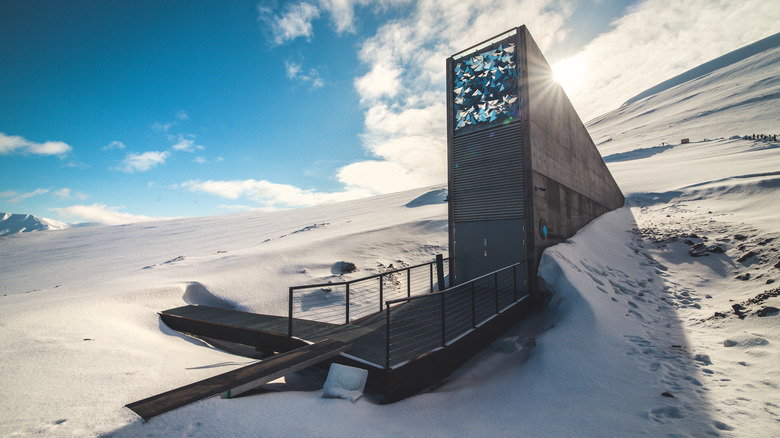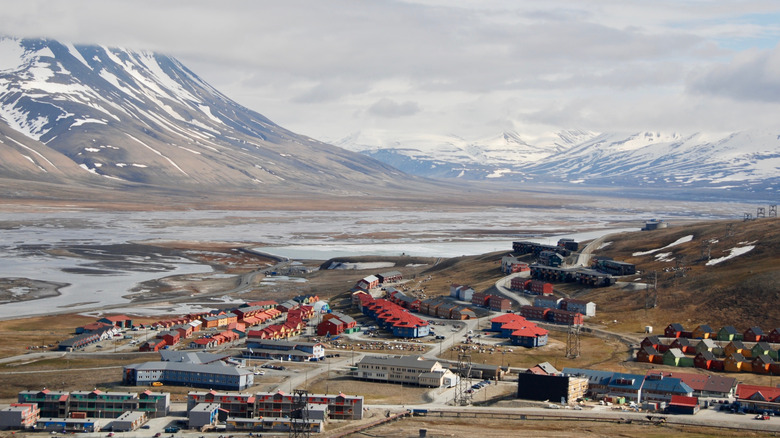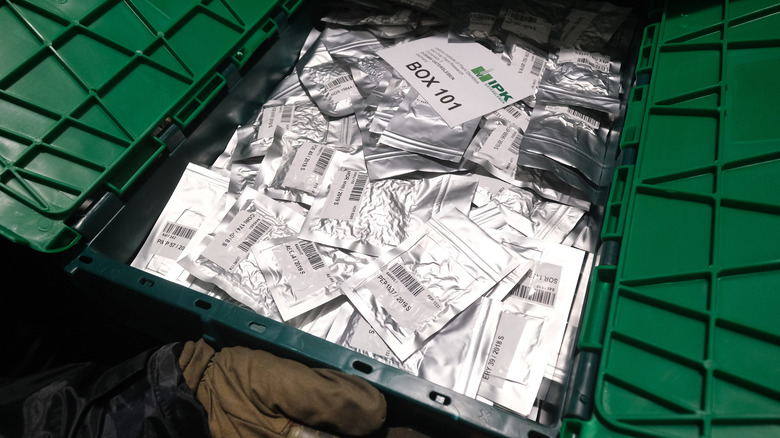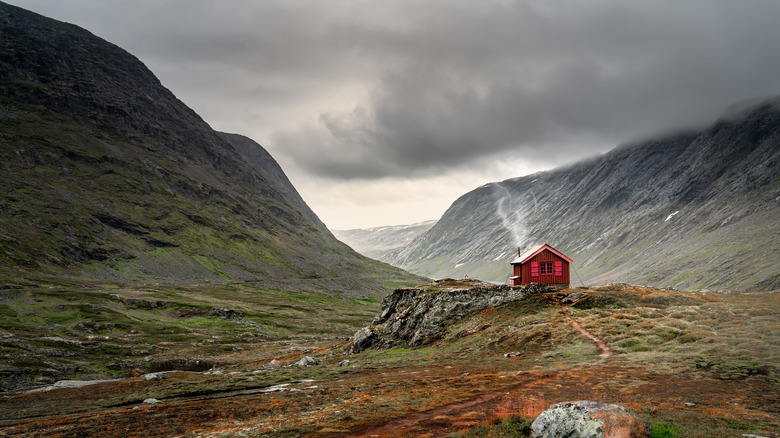How The Norwegian Seed Vault Is Preparing For The Apocalypse
If our fiction is to be believed, we humans are definitely obsessed with our inevitable demise. We've got death by zombie teeth in the "Walking Dead" (2010-present). We've got death by comet because of an obsession with media-driven fakery in "Don't Look Up" (2021). Sometimes, humans win the day because Will Smith punches an alien invader, and he and Jeff Goldblum somehow upload a computer virus to its mothership ("Independence Day," 1996).
The truth is far less glamorous. When the apocalypse hits, the preservation of civilization won't rely on spectacle and freeze-framed hero poses. It'll depend on the smallest, most critical part of the planet's entire lifecycle: seeds, the foundation of almost all food.
Lots of varieties of fruit, vegetables, and fungi — biodiversity — are key to a thriving ecosystem. However, in the past 250 years, about 600 plants species have been lost due to humanity's abuse of the natural world, per the BBC. And as The Guardian says, two in five species are at further risk of extinction. Meanwhile, per the UN Department of Economic and Social Affairs, the human population is set to hit 11.2 billion by 2100. Around the same time, ocean levels will rise by 8.2 feet, per Climate.gov, and the 38% of global land now occupied by food production (per the Food and Agriculture Organization of the United Nations) will be displaced as urban centers migrate inland.
Wisely expecting the worst, the Svalbard Global Seed Vault stands ready to protect humanity from itself.
A Nordic safety deposit box for the world's seeds
The Svalbard Global Seed Vault is a massive underground storage facility built directly into the permafrost of the world's northernmost habitable area: the Svalbard archipelago. Svalbard is a part of Norway, but sits about 925 kilometers (575 miles) north from the country's northernmost major city, Tromsø. Svalbard occupies a range of 74 to 80 degrees latitude, which means that its highest annual temperature caps at about 6.7 degrees Celsius in July (44 Fahrenheit), as Climates to Travel tells us. And for the record: Yes, people do live up there. Svalbard's main town, Longyearben, contains about 2,300 hardy, thermal-jacketed inhabitants, per the BBC.
In other words, Svalbard is the perfect place for a "seed vault," a safety deposit box for the world's seeds. People and communities from across the globe, like those from Nigeria depicted on the Norwegian Government Security and Service Organisation website, can zip up their seeds in sealed containers and ship them off to Norway for safe-keeping behind lock-and-key in one of the facility's three "rock vaults." These people still own their seeds, but unlike other seed banks, cannot withdraw them willy-nilly. The idea is to create a "safety stock" of "genetic diversity" in order "to recreate valuable plant varieties whose seed collections in a local gene bank are lost." In other words, if things go south topside and the world is in dire straights, we have a backup.
Billions of seeds safe for millennia
There are currently 4,051 species housed in the Svalbard Global Seed Vault, and 1,125,416 individual seeds, as the Norwegian Government Security and Service Organisation website reports. The October 2021 shipment (deposits occur at regular intervals) saw 14,011 new seeds carried to the vault from 12 different locations, including first-time storage of traditional crops from Serbia and Latvia. This brings the total number of worldwide depositors up to 89.
Other October depositors included the John Innes Center in the United Kingdom, The International Livestock Research Institute (ILRI) in Kenya and Ethiopia, and the National Rice Seed Storage Laboratory for Genetic Resources (NRSSL) in Thailand. The vault's largest overall depositor is Mexico, whose International Wheat and Maize Improvement Center (CIMMYT) has deposited 177,850 seeds from 12 total species of maize (corn) and wheat.
Crop Trust, one of the organizations who work with the seed vault, says that Norway built the vault with $9 million of its own money, which easily makes it the most cost-effective, life-saving investment in the history of ever. It's located 120 meters (393.7 feet) into the rock of Platåberget ("plateau mountain"), meaning that even if the vault's mechanical cooling system fails and temperatures outside continue to boil Earth, the vault will remain at a stable -18 Celsius (0.4 Fahrenheit). The seeds, sealed in special, four-layered foil containers, are safe for literally thousands of years, if necessary. The entire vault can house 2.25 billion individual seeds from 4.5 million species.
A marvel of international diplomacy open for tours
The Svalbard Global Seed Vault is something of a marvel of international diplomacy and cooperation. It's the kind of venture that indicates that humanity just might eke its way through at least another 100 years. Maybe.
The vault was completed in 2008, as the Svalbard Global Seed Vault website says. Plans and discussions, however, began as far back as the 1980s. In 1984, the Nordic Gene Bank built a seed storage facility in Longyearben, the aforementioned town in Svalbard. At present, the Nordic Gene Bank (now NordGen) operates in a complementary way to the Svalbard Global Seed Vault. As the NordGen website says, they have about 33,000 seed samples available for researchers to order for scientific purposes.
The 2001 International Treaty on Plant Genetic Resources for Food and Agriculture (ITPGRFA) paved the way for the Svalbard seed vault to be built. Norway stepped up to the plate, proposed the location based on a 2004 "feasibility study," and presto: Four years later we got the world's chief backup storage unit for its food supplies. It took decades of work and agreements across global governments to allow for the construction of such a facility.
At present, Svalbard's few-and-far-between visitors can actually take a tour of the vault. Visit Svalbard offers tours from a bit over $100 per person. They include a four-hour hike through the nearby tundra, transportation to and from your accommodations, and of course, optional snow shoes.



